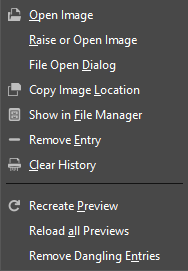Le dialogue des documents conserve la trace des documents que vous avez ouverts au cours des sessions précédentes. Il est plus complet que la liste que vous obtenez avec la commande « Récemment ouverts ». Ne confondez pas l’Historique des documents avec l’Historique d’annulation qui conserve la trace des actions effectuées sur l’image active.
La fenêtre du Presse-papiers est une fenêtre ancrable, voyez la section Dialogues, fenêtres et onglets sur l’utilisation des ancrages.
Vous pouvez y accéder :
-
From the main menu: → → .
-
From the Tab menu in any dockable dialog by clicking on
and selecting → .
-
From the main menu: → → .
La barre de déplacement vous permet de naviguer parmi toutes les images que vous avez déjà ouvertes.
Dans le menu d’onglet de la fenêtre « Historique des documents », vous pouvez choisir entre et . En mode Grille, les documents sont disposés dans un tableau rectangulaire. En mode Liste, chaque rang est occupé par une miniature du contenu du document, avec son nom et ses dimensions en pixels.
![[Astuce]](images/tip.png)
|
Astuce |
|---|---|
|
Ctrl+F ouvre un champ de recherche. Voir View as List |
Use the Open the selected entry
button or command of the dialog's
context menu, to open the image you have selected. With the
Shift key pressed, it raises an image hidden behind
others. With the Ctrl key pressed, it opens the Open
Image dialog.
Use the Remove the selected entry
button or command of the dialog's
context menu, to remove an image from the History dialog. The image
is removed from the recently open images list also. But the image itself
is not deleted.
Use the Clear the entire file history
button or command of the
dialog's context menu, to remove all the files from the history.
Use the Recreate Preview
button or command of the
dialog's context menu, to update preview in case of change.
With Shift key pressed, it acts on all previews.
With Ctrl key pressed, previews that
correspond to files that can't be found out, are deleted.
- Généralités
-
You can get the document history context menu by right clicking on a file in the document history dialog, or by clicking the tab menu button
and opening the submenu. Several of the operations are also available through buttons at the bottom of the dialog. Those operations are documented above. The remaining ones are listed below.





